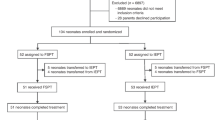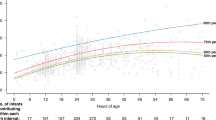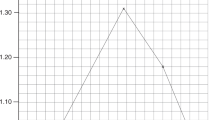Abstract
Objective:
To evaluate the effect of supine position when compared with periodic change of position during phototherapy in late preterm and term neonates (35 to 42 weeks) with hyperbilirubinemia on the duration of phototherapy.
Study Design:
We randomly allocated enrolled neonates with hyperbilirubinemia to either no change in position (supine group (SG); n=54) or two-hourly change of position from supine to prone and vice versa (turning group (TG); n=46). All the infants received single surface phototherapy by two dedicated compact fluorescent light units. Total serum bilirubin (TSB) was measured at the start of phototherapy and then every 12±2 h until the end of phototherapy. Phototherapy was stopped when two values were below the cut-off for age and gestational age as per the American Academy of Pediatrics Subcommittee on Hyperbilirubinemia guidelines nomogram for the management of hyperbilirubinemia in infants >35 weeks of gestation. The primary outcome was duration of phototherapy and secondary outcome was rate of fall of bilirubin within the first 24±2 h after the initiation of phototherapy.
Result:
Baseline characteristics including birth weight (g, 2752±478 vs 2748±416 P=0.96), gestation (week, 37.1±1.2 vs 37.4±1.3, P=0.26) were similar in the two groups. There was no difference in the duration of phototherapy between the SG (mean±s.d., hour, 25.5±8) and TG (mean±s.d., hour, 24.8±5), mean difference (95% confidence interval), hour, 0.7 (−2.03, 3.44, P=0.6). Rate of fall of bilirubin was also similar in both supine and turning groups with mean difference of −0.020 (95% confidence interval: −0.061, 0.021, P=0.34).
Conclusion:
Nursing babies in supine position when compared with periodic position change during phototherapy does not decrease the duration of phototherapy.
This is a preview of subscription content, access via your institution
Access options
Subscribe to this journal
Receive 12 print issues and online access
$259.00 per year
only $21.58 per issue
Buy this article
- Purchase on SpringerLink
- Instant access to full article PDF
Prices may be subject to local taxes which are calculated during checkout

Similar content being viewed by others
References
Cremer RJ, Perryman PW, Richards DH . Influence of light on the hyperbilirubinaemia of infants. Lancet 1958; 1: 1094–1097.
Maisels MJ . Phototherapy—traditional and nontraditional. J Perinatol 2001; 21 (Suppl 1): S93–S97.
Vogl TP, Hegyi T, Hiatt IM, Polin RA, Indyk L . Intermediate phototherapy in the treatment of jaundice in the premature infant. J. Pediatr 1978; 92: 627–630.
Lau SP, Fung KP . Serum bilirubin kinetics in intermittent phototherapy of physiological jaundice. Arch Dis Child 1984; 59 (9): 892–894.
Yamauchi Y, Kasa N, Yamanouchi I . Is it necessary to change the babies’ position during phototherapy? Early Hum Dev 1989; 20: 221–227.
Chen C-M, Liu S-H, Lai C-C, Hwang C-C, Hsu H-H . Changing position does not improve the efficacy of conventional phototherapy. Acta Paediatr 2002; 43: 255–258.
Mohammadzadeh A, Bostani Z, Jafarnejad F, Mazloom R . Supine versus turning position on bilirubin level during phototherapy in healthy term jaundiced neonates. Saudi Med J 2004; 25: 2051–2052.
Shinwell ES, Sciaky Y, Karplus M . Effect of position changing on bilirubin levels during phototherapy. J Perinatol 2002; 22: 226–229.
Donneborg ML, Knudsen KB, Ebbesen F . Effect of infants’ position on serum bilirubin level during conventional phototherapy. Acta Paediatr 2010; 99: 1131–1134.
Maisels MJ, Baltz RD, Bhutani VK, Newman TB, Palmer H, Rosenfeld W . Management of hyperbilirubinemia in the newborn infant 35 or more weeks of gestation. Pediatrics 2004; 114: 297–316.
Health NCC for W and C 2012 CG98 Neonatal jaundice: full guideline. NICE. (cited 24 August 2012), (available from http://www.nice.org.uk/).
Hunt CE, Lesko SM, Vezina RM, McCoy R, Corwin MJ, Mandell F et al. Infant sleep position and associated health outcomes. Arch Pediatr Adolesc Med 2003; 157: 469–474.
Bhutani VK . Phototherapy to prevent severe neonatal hyperbilirubinemia in the newborn infant 35 or more weeks of gestation. Pediatrics 2011; 128: e1046–e1052.
Djokomuljanto S, Quah BS, Surini Y, Noraida R, Ismail NZN, Hansen TWR et al. Efficacy of phototherapy for neonatal jaundice is increased by the use of low-cost white reflecting curtains. Arch Dis Child Fetal Neonatal Ed 2006; 91: F439–F442.
Eggert P, Stick C, Swalve S . On the efficacy of various irradiation regimens in phototherapy of neonatal hyperbilirubinaemia. Eur J Pediatr 1988; 147: 525–528.
Vogl TP . Phototherapy of neonatal hyperbilirubinemia: bilirubin in unexposed areas of the skin. J Pediatr 1974; 85: 707–710.
Ozkan H, Oren H, Duman N, Duman M . Dermal bilirubin kinetics during phototherapy in term neonates. Acta Paediatr 2003; 92: 577–581.
Acknowledgements
The equipment was provided by Phoenix Medical system and Natus Medical.
Author Contributions
Dr Sainath Bhethanabhotla had primary responsibility for protocol development, patient screening, enrollment, outcome assessment and writing the manuscript. Dr Anu Thukral supervised the execution of the study and contributed to the writing of the manuscript. Dr M Jeeva Sankar and Dr Vinod Kumar Paul participated in the development of protocol and analytical framework for the study. Dr Ramesh K Agarwal participated in the development of protocol and analytical framework for the study, and performed the final data analyses. Dr Ashok K Deorari participated in the development of protocol, provided analytical framework for the study, supervised the screening and contributed to the final outcome assessment and writing the manuscript.
Author information
Authors and Affiliations
Corresponding author
Ethics declarations
Competing interests
The authors declare no conflict of interest.
Rights and permissions
About this article
Cite this article
Bhethanabhotla, S., Thukral, A., Sankar, M. et al. Effect of position of infant during phototherapy in management of hyperbilirubinemia in late preterm and term neonates: a randomized controlled trial. J Perinatol 33, 795–799 (2013). https://doi.org/10.1038/jp.2013.54
Received:
Revised:
Accepted:
Published:
Issue date:
DOI: https://doi.org/10.1038/jp.2013.54
Keywords
This article is cited by
-
The impact of hemoglobin on the efficacy of phototherapy in hyperbilirubinemic infants
Pediatric Research (2017)
-
Intermittent versus continuous phototherapy for the treatment of neonatal non-hemolytic moderate hyperbilirubinemia in infants more than 34 weeks of gestational age: a randomized controlled trial
European Journal of Pediatrics (2015)



